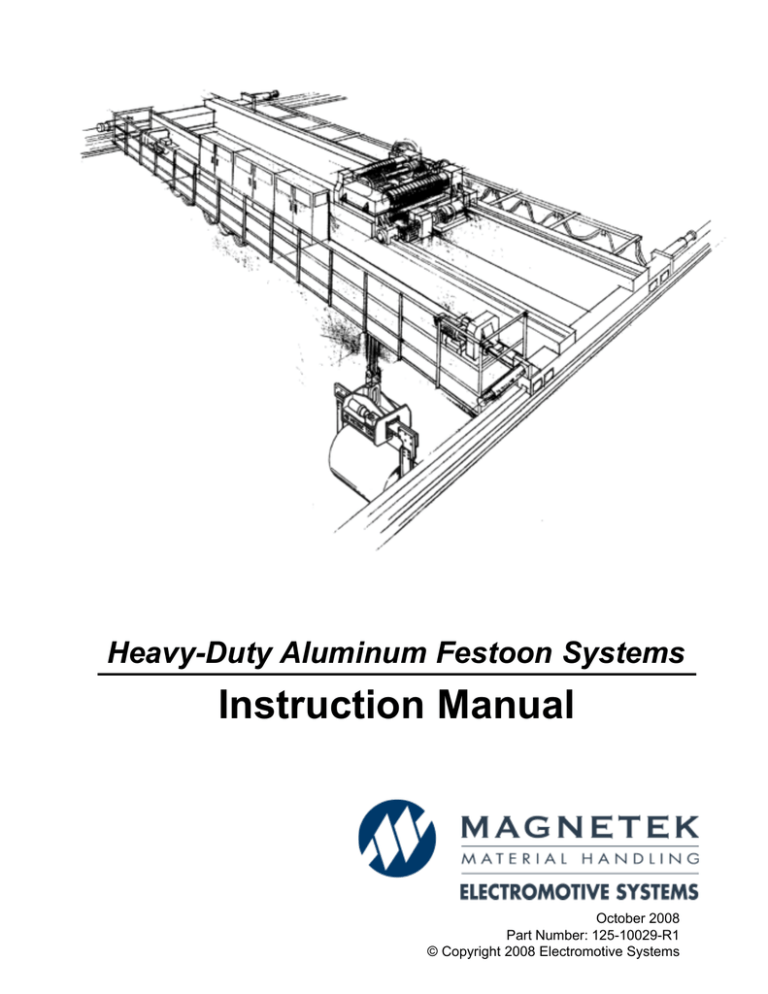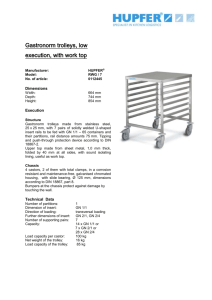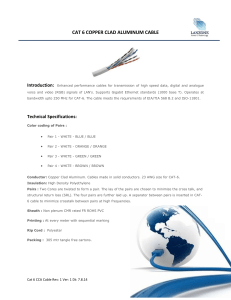
Heavy-Duty Aluminum Festoon Systems
Instruction Manual
October 2008
Part Number: 125-10029-R1
© Copyright 2008 Electromotive Systems
©2008 MAGNETEK
All rights reserved. This notice applies to all copyrighted materials included with this product,
including, but not limited to, this manual. This manual is intended for the sole use of the persons to
whom it was provided, and any unauthorized distribution of the manual or dispersal of its contents is
strictly forbidden. This manual may not be reproduced in whole or in part by any means whatsoever
without the expressed written permission of MAGNETEK.
DANGER, WARNING, CAUTION, and NOTE Statements
DANGER, WARNING, CAUTION, and Note statements are used throughout this manual to
emphasize important and critical information. You must read these statements to help ensure safety
and to prevent product damage. The statements are defined below.
DANGER
DANGER indicates an imminently hazardous situation which, if not avoided, will result in
death or serious injury. This signal word is to be limited to the most extreme situations.
WA R N I N G
WARNING indicates a potentially hazardous situation which, if not avoided, could result in
death or serious injury.
CAUTION
CAUTION indicates a potentially hazardous situation which, if not avoided, could result in
minor or moderate injury. It may also be used to alert against unsafe practices.
NOTE:
A NOTE statement is used to notify people of installation, operation, programming,
or maintenance information that is important, but not hazard-related.
Heavy-Duty Aluminum Festoon System– October 2008
1
Heavy-Duty Aluminum Festoon System Installation Instructions
General Considerations
1. Determine the length of the span to be festooned with consideration given to the storage distance
(stack up) impact upon the actual travel distance of the moving equipment and the speed at
which the system will run.
a. To determine storage/stack up area, multiply length of trolley by number of trolleys
to acquire storage length (i.e. 5” long trolley x 10 trolleys = 50”)
b. To determine the length of track required, add the sum of the storage distance, the
working travel, and ½ the length of the lead trolley. Consider that Heavy Duty
Aluminum Track is available in either 10 or 20 foot standard sections or can be supplied
in cut-lengths of whole foot increments.
c. Heavy Duty Aluminum sections may also be curved to a special radius and degree of arc
(minimum radius 36”)–please consult factory.
d. For systems with speeds of 250 feet per minute or more, consult the factory, as tow
cables/chains may be required.
2. Determine the desired loop depth. A 3-foot loop depth is common. A deeper loop depth requires
fewer trolleys and reduces the storage (stack up) distance.
3. Select proper Flat Cable that meets or exceeds the electrical requirements of the application
based upon the amperage and conductors required. The total number of control wires should
include one common and one ground. Additional wires may be required for brakes, limit
switches, or other devices when controls are mounted remotely from their motors.
a. The length of cable required is the sum of the length of track, plus approximately 20%
for cable sag, plus the distance to power source.
b. Calculate total weight of cable per trolley to ensure that a maximum of 150 lbs. per
trolley is not exceeded–see cable data sheet. Cables may be stacked in the saddle so long
as the maximum weight per trolley is not exceeded.
4. Determine the track support/hanger spacing. Recommended hanger spacing is 10 ft. centers.
a. It may be necessary to add another support/hanger in the storage/stack up area caused
by additional weight when trolleys accumulate in storage area and heavier gauge cables
are used.
b. Consult factory for proper support spacing on curved systems. Most curved systems are
supported every 2½ feet on each curve and every 10 feet on straight sections.
5. Determine the number of trolleys required by dividing the length of the run by the total amount
of cable required for one loop. (i.e. A 3 foot loop depth requires 6 feet of cable). The number of
intermediate trolleys will be reduced by (1) to account for a lead/tow trolley or control box
trolley. Trolleys for anti-lift rollers are recommended for curved systems.
6. Determine the junction box size and terminal strips required for the amount of conductors being
festooned from the power source and/or the control box trolley. Cable grips are available for
terminating cable in various sizes and multiple cable accommodations.
Heavy-Duty Aluminum Festoon System– October 2008
2
Heavy-Duty Aluminum Standard Configuration
Figure 1
Standard System Components
Part No.
Description
Page Number
*Tech. Bulletin #
F-HT10
Heavy Duty Aluminum Track Section – 10 foot
6
FS-HT1
F-HT20
Heavy Duty Aluminum Track Section – 20 foot
6
FS-HT1
F-HT “X”
Cross Arm Brackets – “X” = 1 foot increments
6
FS-HT1
FS-HTJ
Joint Assembly - 2 piece
6
FS-HT1
F-HTA
Tow Arm/Cable Saddle Assembly
7
FS-HT5
F-HTH
Heavy Duty Aluminum Hanger Assembly-2 piece
7
FS-HT2
F-HTE
Heavy Duty End Cable Clamp
8
FS-HT2
F-HTS
Heavy Duty End Stop Assembly
9
FS-HT6
F-HCB
Heavy Duty Control Box Trolley
9
FS-HT6
F-HC3
Heavy Duty Intermediate Trolley – 3” frame
10
FS-HT8
F-HC5
Heavy Duty Intermediate Trolley – 5” frame
10
FS-HT8
Additional Components:
Pendant pushbutton stations and round pendant cable available in standard and custom
configurations–consult factory
Trolleys and Anti-Lift Rollers also available-recommended for curved systems
Corrosion Resistant and Part Resistant Trolleys also available
Components for multiple saddle and/or round cable also available–consult factory
* For your reference technical bulletins for most components maybe requested by calling the factory or are available online at www.magnetekmh.com under “Document Center” in the Festoon Section of the “Applications Bulletins” page.
Heavy-Duty Aluminum Festoon System– October 2008
3
Installation Procedures (refer to drawing–figure 1)
1. Install angle, channels, etc., support brackets (supplied by others)–welded or bolted to beam,
sufficient to carry 250 lbs. each.
2. Install Track Hangers on support brackets with fasteners furnished. Leave the mounting bolts
loose so Aluminum Heavy Duty Track can be inserted.
3. Install Aluminum Heavy Duty Track into Hanger Clamps. Tighten the Hanger Clamps slightly
to allow the track to move when installing Track Joints. Once the Track Joints are securely in
place, tighten the Hanger Clamps firmly.
4. Join Aluminum Heavy Duty Track sections together by installing the two piece Track Joint onto
the track. Slide the half-moon shaped track joint piece into the bottom area of the track. Butt
both sections of track together and slide the bottom Track Joint into the joining track, centering
the Track Joint. Tighten the set screws firmly to lock track into place. Next, mount the top joint
plate and tighten the hardware (carriage bolts should be pointing up) securely in place.
5. Insert the Lead/Tow Trolley or Control Box Trolley and intermediate Cable Trolleys onto the
Aluminum Track – make sure all trolleys roll freely.
6. Install the End Cable Clamp assembly onto the Aluminum Track at the cable storage end.
Tighten securely.
7. Install the End Stop on the Aluminum Track end, opposite the storage end.
8. Loosen (but do not remove) the wing nuts on the trolley saddles. Feed the festoon cables into the
trolleys between the clamping pad and saddle. Make sure to leave enough cable past the Tow/
Lead Trolley or Control Box Trolley to wire into enclosure. Measure the desired loop depth and
tighten the wing nuts to secure the festoon cables.
9. Install festoon cable grips into approved junction boxes and insert cables through the cable
glands. Tighten cable grip nuts firmly to secure cables.
10. For power & control applications, install the Tow Arm in the center of the rectangular box
mounted on the Tow/Lead Trolley. The Tow Arm should be securely fastened to the moving
equipment to be electrified.
11. For traveling pendant pushbutton applications, install the junction box on the Control Box
Trolley. Fasten securely with hardware furnished.
12. Run the entire festoon system back and forth several times over the entire system to ensure
proper operation. Flat festoon cables should extend and retract in a straight line if the cables
have been properly fastened to the trolleys.
Heavy-Duty Aluminum Festoon System– October 2008
4
Flat Festoon Cables and Trolleys–Engineering Data
Trolley Specifications
•
•
•
•
•
•
150 lb. capacity each Trolley
Trolleys equipped with ball bearing wheels capable of traveling up to 250 feet per minute
Trolleys can be supplied with anti-lift rollers
Corrosion resistant Trolley includes expoxy coated steel parts and steel wheels
Spark Resistant Trolley includes stainless steel parts and brass wheels
Consult factory for systems with speeds of 250 feet per minute or higher
Cable Saddle Specifications
•
•
3” and 5” Trolleys have a 3” diameter nylon cable saddle with 1” X 2¼” maximum cable
opening
3” and 5” Trolley frames available with multiple saddle configurations for flat or round cable–
consult factory
Flat Festoon Cable Reference–Standard Cable Specifications
•
•
•
•
•
•
•
•
Indoor/Outdoor Festoon flat cable and round pendant control cable
105°C (221°F) 600 volt AC, 250 volt DC
Conductors are annealed copper
Each conductor has color coded jacket
Jacket rating -40°C (-40°F) to 105°C (221°F)
Resistant to UV, ozone, water, oil and weather
4, 8, or 12 conductor flat cable
#2 AWG through #16 AWG flat cable
AWG Size
# of Cond.
Dimensions
(Inches)
Ampacity*
Approximate
lbs/MFT
Bend Radius
(in.)
F-16/8
16
8
0.200 X 1.110
14
194
0.80
F-16/12
16
12
0.200 X 1.605
14
292
0.80
F-14/4
14
4
0.210 X 0.625
27
138
0.84
F-14/8
14
8
0.210 X 1.175
19
254
0.84
F-14/12
14
12
0.210 X 1.700
19
380
0.84
F-12/4
12
4
0.230 X 0.710
33
180
0.92
F-12/8
12
8
0.230 X 1.340
23
343
0.92
F-10/4
10
4
0.270 X 0.880
44
239
1.08
F-8/4
8
4
0.365 X 1.190
60
401
1.46
F-6/4
6
4
0.430 X 1.450
82
620
1.72
F-4/4
4
4
0.490 X 1.690
104
896
1.96
F-2/4
2
4
0.560 X 1.955
142
1278
2.24
Part No.
*Ampacities are de-rated at higher temperatures (above 30°C).
Minimum Bending Radius (approx. 4 X cable thickness)
Specialty cable also available–contact the factory for more information
Cable available in specific lengths or in Full Reels of 500 or 1000 feet
–Not suitable for 3” diameter saddle
Heavy-Duty Aluminum Festoon System– October 2008
5
Heavy Duty Aluminum Track
"X"
.06
Figure 1
F-HT10
F-HT20
F-HTX
Heavy Duty Aluminum Track x 10’–0” (+/- 0.125”)
Heavy Duty Aluminum Track x 20’–0” (+/- 0.125”)
Heavy Duty Aluminum Track x “X” Length
1.0 lbs/ft.
Heavy Duty Aluminum Joint Assembly
Figure 2
F-HTJ
Heavy Duty Aluminum Joint Assembly (2 Piece Assembly)–1.0 lbs./ft.
Heavy-Duty Aluminum Festoon System– October 2008
6
Heavy Duty Tow Arm/Cable Saddle Assembly
Figure 3
F-HTA
Heavy Duty Tow Arm/Cable Saddle Assembly
F-HTA-SS Heavy Duty Stainless Steel Tow Arm/Cable Saddle Assembly
3.25 lbs/ea.
Heavy Duty Aluminum Track Hanger Assembly
Figure 4
F-HTH
Heavy Duty Aluminum Track Hanger Assembly (2 Piece Assembly)
0.80 lbs./assembly
Heavy-Duty Aluminum Festoon System– October 2008
7
Heavy Duty End Cable Clamp
Figure 5
F-HTE
Heavy Duty End Cable Clamp
F-HTE-SS Heavy Duty Stainless Steel End Cable Clamp
0.90 lbs./ea.
Heavy-Duty Aluminum Festoon System– October 2008
8
Heavy Duty End Stop Assembly
Figure 6
F-HTS
Heavy Duty End Stop Assembly
F-HTS-SS Heavy Duty Stainless Steel End Stop Assembly
0.60 lbs./assembly
Heavy Duty Control Box Trolley
Figure 7
F-HCB
Heavy Duty Control Box Trolley
F-HCBX1 Heavy Duty Corrosion Resistant Control Box Trolley (Stainless Steel Wheels and
Hardware)
5.20 lb./ea.
Heavy-Duty Aluminum Festoon System– October 2008
9
Heavy Duty Aluminum Trolley
Figure 8
F-HC3
Heavy Duty Aluminum Trolley–0.85 lbs./ea.
Figure 9
F-HC5
Heavy Duty Aluminum Trolley
F-HC5X1 Heavy Duty Aluminum Corrosion Resistant Trolley (Stainless Steel Wheels and
Hardware)
1.25 lbs./ea.
Heavy-Duty Aluminum Festoon System– October 2008
10




